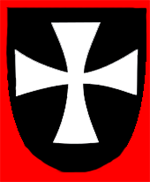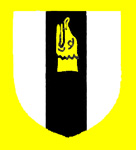The Manor of Little Staughton
Jeanette Atkinson and Brenda Foster have been working on adding Community Archive pages for Little Staughton.
Volume III of The Victoria County History for Bedfordshire published in 1912 provides complete information on the Manor of Little Staughton. Manors originated in Anglo-Saxon times and the manorial system dictated who owned land, peoples’ rights as tenants and the taxes due. The manor was the dominant form of tenure of land and this system was well established by the Norman Conquest. No new manors were created after 1279 and during the 16th and 17th centuries many of the manorial functions were transferred to the appropriate parish authorities.

Arms of the Knights Templar
The earliest record of a landowner in Little Staughton is of a John de Stocton in 1206 but there is involvement of the Knights Templar (a charitable military order) that held the Manor of Little Staughton in the 12th and 13th centuries. Many of the Templars were not warrior knights but led a semi-monastic life and thus were essentially estate managers. There were Templar-run Manors at neighbouring Pertenhall and Melchbourne, which was a Preceptory or local headquarters. Although the Templars were powerful for almost 200 years (1119 – 1312), they were disbanded on the order of Pope Clement V in 1312 after they had been outlawed by the French King Phillip IV in 1307 on grounds of heresy, blasphemy and sodomy. Templar assets were seized by all heads of state and, after deductions, eventually returned to the Knights of Saint John of Jerusalem also known as the Knights of Malta but often known as the ‘Hospitallers’. This group was founded in 1113 by Italian merchants from Amalfi to care for sick and poor pilgrims in Jerusalem. In many ways similar to the Templars, the Hospitallers were more politically aware and have survived to the present day.

Arms of the Knights Hospitaller
The Peyvre and Darrel families (Lords of Pertenhall Manor in the 13th to 15th centuries) also held land in Little Staughton from 1253. There is a Whickey Farm in Little Staughton to the present day, which is possibly related to a Whikey Manor, Pertenhall that was recorded briefly in 1518. In addition, the Priors of Bushmead and Chicksands owned land in Little Staughton until the Dissolution of the Monasteries by King Henry VIII circa. 1536.
The Manor of Little Staughton was held by various organisations and families as follows.
- In 1318 most of the Templar property in Little Staughton passed to the Knights of Saint John of Jerusalem who then passed the Manor of Little Staughton to John the Bishop of Ely for life.
- By 1330 John de Waldeshef became Lord of the Manor.
- In 1337 the Manor reverted again to the Knights of Saint John of Jerusalem.
- Dissolution of the monasteries (circa 1536/9 for the Little Staughton area), saw Henry VIII grant lands in Little Staughton to William Gascoigne of Cardington who worked for Cardinal Wolsey.

Arms of the Gascoigne family
- Anthony Cockett was leased the parish in 1545 and then granted the Manor in 1546.
- From 1547 to 1650 the Wade-Gery family held Little Staughton Manor; significant memorials of this family exist in the parish church (All Saints’).
- 1650 to 1700 John Spicer held the manorial title.
- From 1700 Little Staughton Manor was sold to the Kingsley family who remained as Lords of the Manor until 1749. After the death of Haylock Kingsley in 1749, William Pym (son-in-law) inherited the Manor and the title of Lord of the Manor. When the parish was inclosed in 1801 to 1803, the Pym family were still in residence.
The manorial system was ended by legislation in the 1920’s.